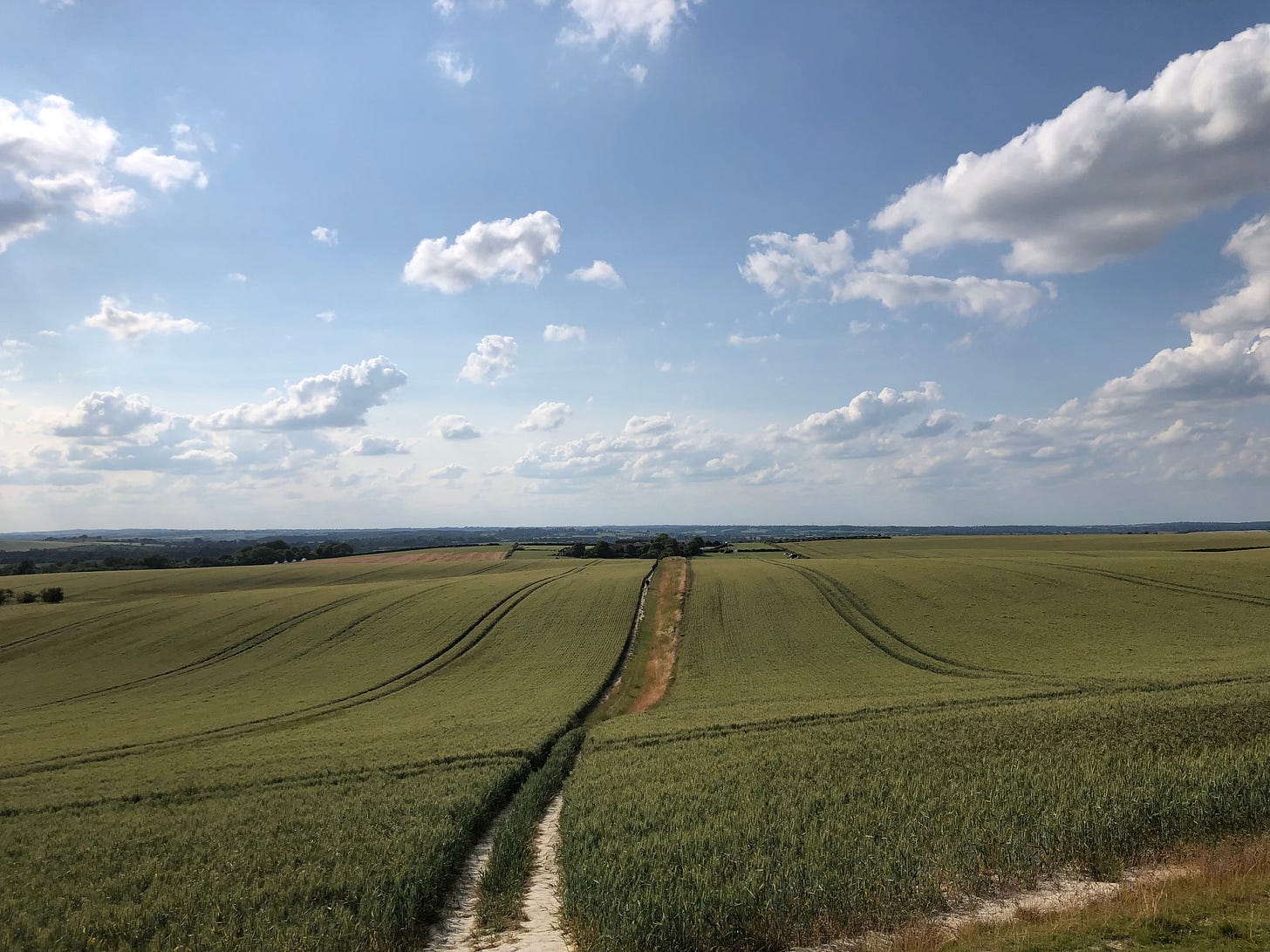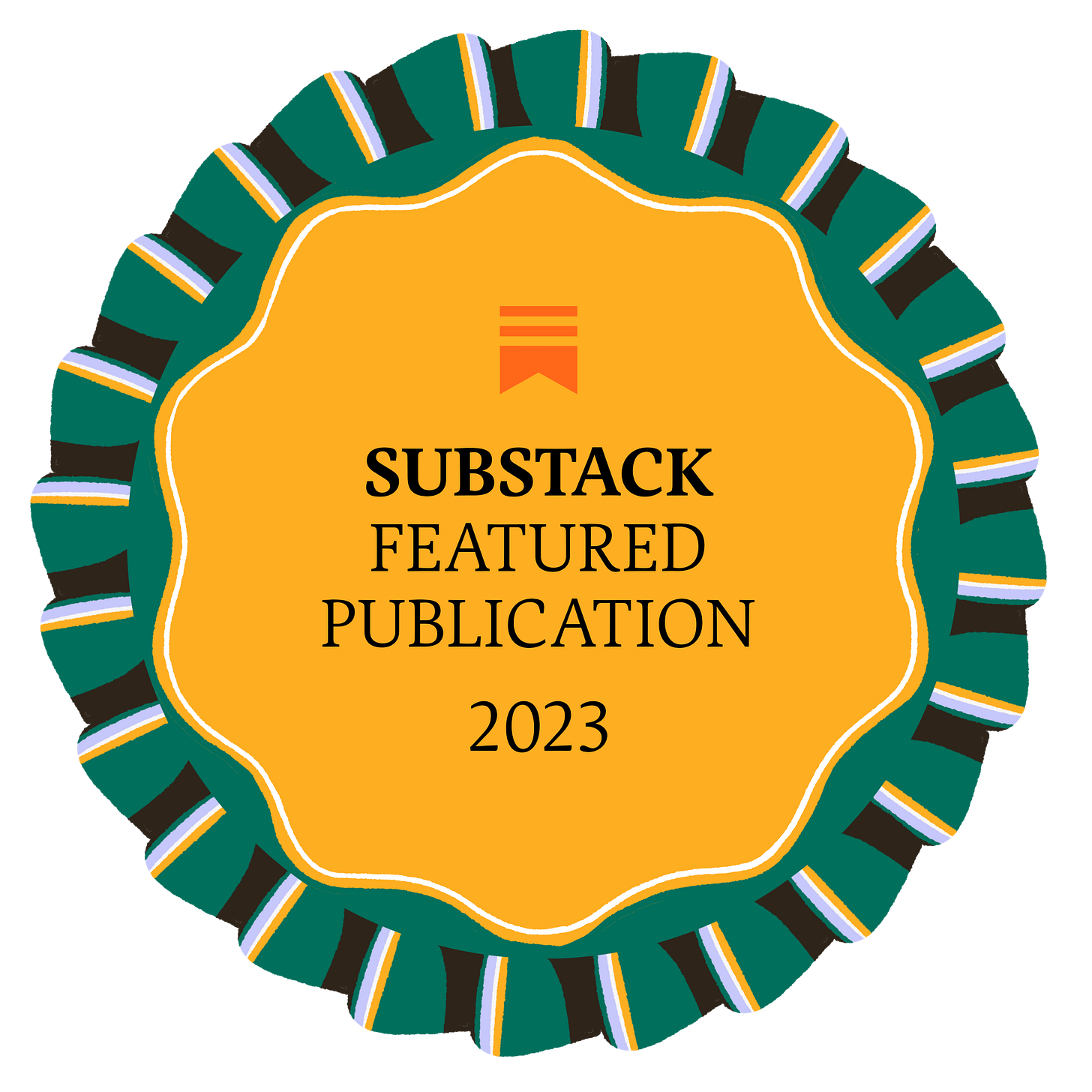In which Rebecca considers the comparative navigational merits of a straight-line walk, a circular path and an out-and-back route, and wonders whether allowing herself to get lost would be a good thing.
Dear Reader,
As a disorient I sometimes feel as if I’m wired to go round in circles, but I try to remind myself that I don’t have to follow that route.
For a while now my walking routine has been on hold, but the call to the great outdoors grows ever stronger. Jim’s thoughtful recurring annual gift of a subscription to the OS Maps app means that I can plan a route for a walk and know that if I lose my way my phone will rattle me into action to find the right path.
Yet even with supporting technology I find it difficult to accurately find my way around and get to where I want to go.
I’m tempted to take just a single path for each walk. I could pick a specific footpath each time, and simply follow it wherever it takes me until it’s time to turn around and come back. I can’t go far wrong, surely?
🤔
Waymarked paths with no junctions to tempt me to go off-piste are one thing, but what about walking in an entirely straight line without deviating for brambles, deep holes, walls, fences, bogs and streams?
I read a fascinating news article a couple of years ago about a couple who had hiked in the Cairngorms of Scotland in a straight line, having plotted their route using this blog post by Ordnance Survey, the national mapping agency for Great Britain.
I’d started my daily walking practice when I’d swapped trainers for walking boots after I’d finally got over my last running injury, but thanks to other commitments – in both the ‘have to’ and ‘want to’ columns on life’s spreadsheet – I haven’t sustained it.
Have I forgotten how to go for a walk?
Maybe that’s why an article in the Saturday Telegraph magazine last month caught my attention.
When did we forget how to go for a walk?
It wasn’t the headline which grabbed me, though, but the subtitle:
It seems we’ve forsaken the art of screen-free strolling. If we no longer let ourselves get lost, navigate by landmark, map and compass, or simply follow the fork in the path, are we missing out of an essential part of our humanity?
🗺️ Let ourselves get lost
Soon after I’d flown out to spend two semesters at a university in Germany a new friend had told me this:
‘To really get to know a place, you need to get lost in it.’
Neither she nor I, at the time, knew that getting lost is such a problem for me. Still, I took her advice and set out to explore, arriving back at our shared flat many hours later both exhausted and terrified, having walked round and round in circles for most of the day.
Telegraph writer Richard Godwin tells this story about getting lost when he and his friend walked the Coleridge Way in Somerset:
Our phones had died; we had no proper map. In short, we were lost.
We decided to push on in the direction we felt to be east. After more gorse and more hills and more cows, we finally gained sight of the sea. We soon rediscovered the path. And finally, at nightfall, we found the inn, where we agreed that the best part of the day was definitely the part where we got lost.
🗺️ Navigate by landmark, map and compass
What are the landmarks? I don’t ever recognise something on my way back which I have passed on the way there. As for a map and compass, I have a mental block. I love to look at maps, but rather than read the topography or follow the lines of rivers and ridges, roads and cycle routes, it is the names I am drawn to.
I mentioned in a recent post that I had known which London street we needed to walk down to get to the Tube station. Jim had been impressed that I’d recognised it.
It wasn’t the street I’d recognised, though, but its sign. Why? Well, it had words on it. So perhaps I need to plan my routes using those? 💡
I don’t get on with maps or compasses, but that’s almost certainly because I haven’t learned how to use them properly. Sam Knight of Ramblers Scotland is encouraging:
…the main point of learning how to navigate is quite simply that it is fun… When you teach people the hard skills of how to navigate using a map and a compass they love it. The joy is making a plan, looking for the clues and relating it back to your map.
Reader, I’m working on it.
🗺️ Simply follow the fork in the path
It’s always a bonus for a walk to have the same start and end points: setting off from and going back to a car park, the railway station, or my own house all mean that I don’t have to rely on outside assistance or the kindness of strangers to get home. I have nothing against walking to somewhere and then back again on the same path, just as long as I remind myself not to expect to recognise a single landmark or junction from my way out again on my way back.
You see, I find it very difficult to retrace my steps. I’m not wired that way. The journey home on an out-and-back walk is always a whole new landscape to me, regardless of whether I’ve turned around in places to imprint landmarks from the direction of the return journey I will be taking later. My inability to make cognitive maps1 renders this an irrelevant practice.
A friend of ours – let’s call her Ms Jones – refuses to take any ‘out and back’ route on principle, and can only enjoy a walk if she knows she will see a new eyeful of landscape with every step. Every time Jim and I set off on a circular route we call it ‘doing a Jonesy’.
Going point-to-point, rather than in a circle or out and back, is the only way to tackle a long trail – the South Downs Way, the South West Coastal Path, the Appalachian Trail or heck, even that iconic road trip along Route 66. For long-distance walking holidays there are agents who can book accommodation and luggage transfers – and, even more importantly, supply maps, written routes and a phone number for if when emergency assistance is required.
🗺️ ‘Getting lost is such an incredible feeling’ – Gareth Fuller
Artist Gareth Fuller adopts the approach of ‘purposeful wondering’, where he heads to an unfamiliar district with the specific aim of getting a bit lost.
Gareth says that he has ‘a compulsion to walk unremittingly, looking beneath the surface of cities and landscapes to discover the distinct systems and stories they hold. The tragedy, romance, folklore and facts wrought by great metropolises become landmarks within my visual storytelling.’
His work ‘is full of incredibly personal memories and encounters. That’s what geography means. It’s about the thoughts and feelings that are triggered by a landscape.’
Gareth’s maps are breathtaking. Take a look here.
Walking coach Sandra Cunningham actively encourages her clients to lose themselves.
A walk is not a walk unless you get a little bit lost. You should try the little path off the main trail. We always obviously find our way back. But a bit of mild adventure and uncertainty – it is really good for people.
Perhaps I’ll have a different experience of getting lost – and even enjoy it – by taking the pressure off. Rather than focusing on the accuracy (or not) of my route planning, or my ability (or not) to follow the right path, whether I am set to get lost or not I need to simply enjoy being out in the world.
However will I know which fork in the path to take? Well, I won’t. Instead, I shall wander with purpose, and look forward to thinking back on the best part of a walk being the point at which I’d got lost.
Love,
Rebecca
If you’ve enjoyed this post, please let me know by clicking the heart. Thank you!
Thank you for reading! If you enjoy ‘Dear Reader, I’m lost’, please share and subscribe for free.
A cognitive map is a type of mental representation which serves an individual to acquire, code, store, recall, and decode information about the relative locations and attributes of phenomena in their everyday or metaphorical spatial environment. The concept was introduced by Edward Tolman in 1948. He tried to explain the behavior of rats that appeared to learn the spatial layout of a maze, and subsequently the concept was applied to other animals, including humans.













Have I ever told the story of my brother attempting a long walk many years ago? We dropped him off early in the morning on a coastline well north of our holiday house. He was so excited to trek through the bush to our place. About mid-afternoon, Mum started to get very worried about him. Can we go look for him? No Mum, not yet. Eventually I said Yes, let’s go. We hopped in my car and drove off. We drove back up the coast and then down the one road that Kevin would cross on his way home. Mum swears I stopped the car and THEN Kevin walked out of the bush. All I remember is the look of absolute relief on his face. He had dreadfully underestimated the time the trek would take and couldn’t believe that we were there waiting for him in exactly the right place before he plunged into the bush on the other side of the road to start the second half of his trek.
Oh, Rebecca, you have given me the best gift ever!!! Your piece today, with all of your immense writing talent and fabulous resources, have addressed the very fear I have suffered with all my life..."What if I get lost?" I could go on and on, but today, I'm going to savor the gift of "Walking in a Straight Line." It is my 63rd birthday today and I asked the Universe to please send me an opening and I have it. It is your experience, and your talent of relaying that experience here on your Substack. Thank you so deeply and dearly.